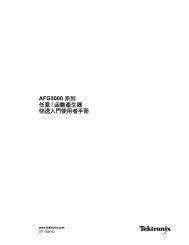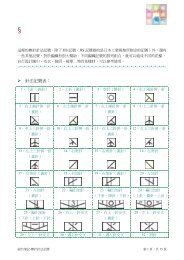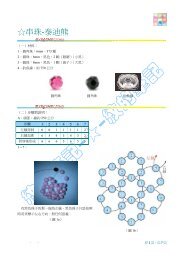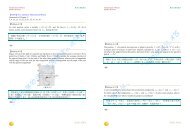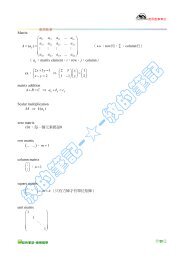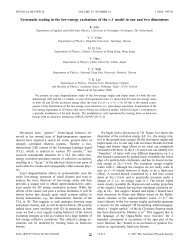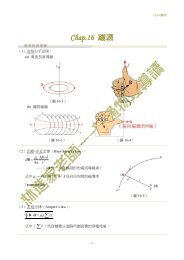Chapter 22 Materials Selection and Design Considerations
Chapter 22 Materials Selection and Design Considerations
Chapter 22 Materials Selection and Design Considerations
You also want an ePaper? Increase the reach of your titles
YUMPU automatically turns print PDFs into web optimized ePapers that Google loves.
W92 • <strong>Chapter</strong> <strong>22</strong> / <strong>Materials</strong> <strong>Selection</strong> <strong>and</strong> <strong>Design</strong> <strong>Considerations</strong><br />
along this line or above it are in the “search region” of the diagram <strong>and</strong> are possible<br />
c<strong>and</strong>idates for this rotating shaft. These include wood products, some plastics, a<br />
number of engineering alloys, the engineering composites, <strong>and</strong> glasses <strong>and</strong> engineering<br />
ceramics. On the basis of fracture toughness considerations, the engineering<br />
ceramics <strong>and</strong> glasses are ruled out as possibilities.<br />
Let us now impose a further constraint on the problem—namely, that the<br />
strength of the shaft must equal or exceed 300 MPa (43,500 psi). This may be represented<br />
on the materials selection chart by a horizontal line constructed at 300 MPa,<br />
Figure <strong>22</strong>.3. Now the search region is further restricted to that area above both of<br />
these lines. Thus, all wood products, all engineering polymers, other engineering alloys<br />
(viz. Mg <strong>and</strong> some Al alloys), as well as some engineering composites are eliminated<br />
as c<strong>and</strong>idates; steels, titanium alloys, high-strength aluminum alloys, <strong>and</strong> the<br />
engineering composites remain as possibilities.<br />
At this point we are in a position to evaluate <strong>and</strong> compare the strength performance<br />
behavior of specific materials. Table <strong>22</strong>.1 presents the density, strength,<br />
<strong>and</strong> strength performance index for three engineering alloys <strong>and</strong> two engineering<br />
composites, which were deemed acceptable c<strong>and</strong>idates from the analysis using the<br />
materials selection chart. In this table, strength was taken as 0.6 times the tensile<br />
yield strength (for the alloys) <strong>and</strong> 0.6 times the tensile strength (for the composites);<br />
these approximations were necessary since we are concerned with strength in<br />
torsion <strong>and</strong> torsional strengths are not readily available. Furthermore, for the two<br />
engineering composites, it is assumed that the continuous <strong>and</strong> aligned glass <strong>and</strong> car-<br />
bon fibers are wound in a helical fashion (Figure 16.15), <strong>and</strong> at a 45� angle refer-<br />
enced to the shaft axis. The five materials in Table <strong>22</strong>.1 are ranked according to<br />
strength performance index, from highest to lowest: carbon fiber-reinforced <strong>and</strong><br />
glass fiber-reinforced composites, followed by aluminum, titanium, <strong>and</strong> 4340 steel<br />
alloys.<br />
Material cost is another important consideration in the selection process. In<br />
real-life engineering situations, economics of the application often is the overriding<br />
issue <strong>and</strong> normally will dictate the material of choice. One way to determine material<br />
cost is by taking the product of the price (on a per-unit mass basis) <strong>and</strong> the<br />
required mass of material.<br />
Cost considerations for these five remaining c<strong>and</strong>idate materials—steel, aluminum,<br />
<strong>and</strong> titanium alloys, <strong>and</strong> two engineering composites—are presented in<br />
Table <strong>22</strong>.1 Density (�), Strength (� f), <strong>and</strong> Performance Index (P) for<br />
Five Engineering <strong>Materials</strong><br />
Material<br />
�<br />
(Mg/m<br />
�f 2�3<br />
�f /� � P<br />
3 ) (MPa) [(MPa) 2�3 m 3 /Mg]<br />
Carbon fiber-reinforced composite<br />
(0.65 fiber fraction)<br />
1.5 1140 72.8<br />
a<br />
Glass fiber-reinforced composite<br />
(0.65 fiber fraction)<br />
2.0 1060 52.0<br />
a<br />
Aluminum alloy (2024-T6) 2.8 300 16.0<br />
Titanium alloy (Ti-6Al-4V) 4.4 525 14.8<br />
4340 Steel (oil-quenched<br />
<strong>and</strong> tempered)<br />
7.8 780 10.9<br />
a<br />
The fibers in these composites are continuous, aligned, <strong>and</strong> wound in a helical fashion at<br />
a 45�<br />
angle relative to the shaft axis.



